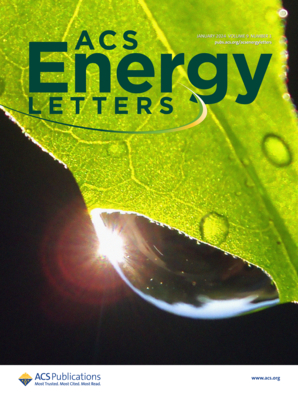In-Situ Self-Encapsulated Tin-Halide Perovskites for Air-Functional Near-Infrared Light-Emitting Diodes
IF 18.2
1区 材料科学
Q1 CHEMISTRY, PHYSICAL
引用次数: 0
Abstract
Tin-halide perovskites are emerging as exceptional materials for near-infrared light-emitting diodes (NIR-LEDs). However, their extreme oxygen sensitivity remains a significant obstacle to practical applications. This work presents a facile yet effective strategy to overcome this limitation by designing self-encapsulated tin-halide perovskite films. Incorporating a rational molecule, 4,4′-diaminodiphenyl sulfone, into precursors, it forms isolated tin-iodide perovskite particles that are encapsulated in situ, achieving outstanding air stability. The resulting films show high crystallinity, reduced trap density, and mitigated p-doping density, boosting radiative charge recombination to reach an impressive photoluminescence quantum yield approaching 50%. Leveraging these advancements, the resulting NIR-LEDs demonstrate a record-breaking peak external quantum efficiency of 12.4%, accompanied by a substantial improvement in operational lifetime. Notably, for the first time, we demonstrated a functional tin-iodide perovskite-based device in ambient air. This work provides a robust pathway for realizing high-performance and stable tin-halide perovskite-based optoelectronic devices, addressing critical challenges for their widespread application.

用于空气功能近红外发光二极管的原位自封装卤化锡钙钛矿
卤化锡钙钛矿正成为近红外发光二极管(nir - led)的特殊材料。然而,它们的极端氧敏感性仍然是实际应用的重大障碍。这项工作提出了一种简单而有效的策略,通过设计自封装的卤化锡钙钛矿薄膜来克服这一限制。将理性分子4,4 ' -二氨基二苯砜纳入前驱体,形成隔离的碘化锡钙钛矿颗粒,这些颗粒被原位封装,具有出色的空气稳定性。所得薄膜显示出高结晶度,降低了陷阱密度,减轻了p掺杂密度,促进了辐射电荷重组,达到了令人印象深刻的接近50%的光致发光量子产率。利用这些进步,由此产生的nir - led显示出创纪录的12.4%的峰值外部量子效率,并伴随着工作寿命的大幅提高。值得注意的是,我们首次在环境空气中展示了一种功能性的碘化锡钙钛矿装置。这项工作为实现高性能和稳定的卤化锡钙钛矿基光电器件提供了一个强大的途径,解决了其广泛应用的关键挑战。
本文章由计算机程序翻译,如有差异,请以英文原文为准。
求助全文
约1分钟内获得全文
求助全文
来源期刊

ACS Energy Letters
Energy-Renewable Energy, Sustainability and the Environment
CiteScore
31.20
自引率
5.00%
发文量
469
审稿时长
1 months
期刊介绍:
ACS Energy Letters is a monthly journal that publishes papers reporting new scientific advances in energy research. The journal focuses on topics that are of interest to scientists working in the fundamental and applied sciences. Rapid publication is a central criterion for acceptance, and the journal is known for its quick publication times, with an average of 4-6 weeks from submission to web publication in As Soon As Publishable format.
ACS Energy Letters is ranked as the number one journal in the Web of Science Electrochemistry category. It also ranks within the top 10 journals for Physical Chemistry, Energy & Fuels, and Nanoscience & Nanotechnology.
The journal offers several types of articles, including Letters, Energy Express, Perspectives, Reviews, Editorials, Viewpoints and Energy Focus. Additionally, authors have the option to submit videos that summarize or support the information presented in a Perspective or Review article, which can be highlighted on the journal's website. ACS Energy Letters is abstracted and indexed in Chemical Abstracts Service/SciFinder, EBSCO-summon, PubMed, Web of Science, Scopus and Portico.
 求助内容:
求助内容: 应助结果提醒方式:
应助结果提醒方式:


